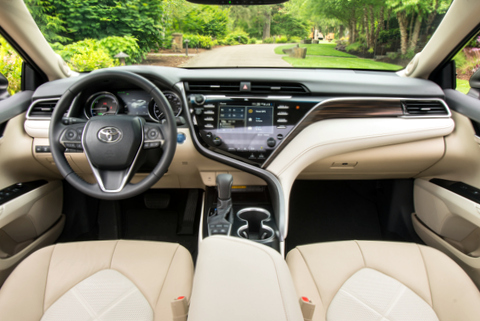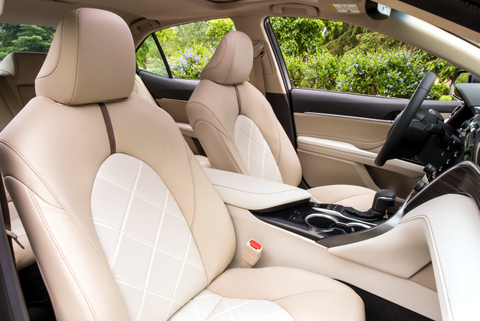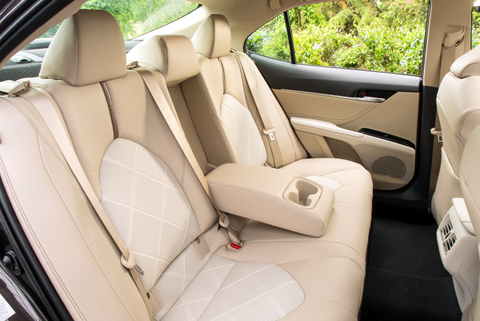California Cruising!
No matter how many times I have driven throughout California, it is always an adventure. Whether it is along the coast, to the desert or high in the mountains, it never gets old. The terrain and scenery change over time, with the light and seasons affecting the diverse landscape of the 31st state.

Recently Toyota handed me the keys to a 2019 Camry Hybrid XLE for what would become an 1,100-mile trip through the Golden State. Departing Southern Orange County and headed to the Sonoma Wine Region, anticipation was high, because, not only is the Camry Hybrid well thought of in the automotive industry, but getting one with only 250 miles on it was an unexpected treat.
Hitting the Open Road
The first thing you will notice when sliding into the Camry Hybrid is how well laid out everything is. It took only a few short minutes to pair the phone and adjust the eight-way power, heated leather driver seat (which included lumbar adjustment). The front passenger, which in this case was my wife, had six-way power adjustments. As I settled in for the journey, I centered the leather-trimmed steering wheel (with controls for audio, hands-free telephone operation, and cruise control) through its tilt and telescopic features.

Next, was becoming familiar with the JBL Premium infotainment (information and entertainment) system that came with Toyota’s Entune and its App Suite. The 8.0-inch high resolution touch-screen, housed the voice command navigation along with SiriusXM/FM/CD/HDAM with MP3 playback capability. The AM/FM is a cache radio, which is a nice feature, and the SiriusXM service is included for 90 days. There is an auxiliary audio jack, USB port with iPod connectivity, music streaming via Bluetooth wireless technology, Siri Eyes Free, and Apple CarPlay. The system came with a subwoofer amplifier to drive the nine speakers.
The 2019 Toyota Camry Hybrid is powered by Toyota’s Hybrid Synergy Drive system of a 2.5-liter, 16-valve double overhead cam (DOHC) gasoline-powered, four-cylinder engine. When combined with the 88-kilowatt electric motor, it has a total system 208 horsepower running through a continuously variable automatic transmission (CVT), which had paddle shifters.
Toyota’s Hybrid Synergy Drive automatically switches between the electric drive mode, combined electric motor and gasoline engine, and gasoline-only engine power. The unnoticeable transitions can be monitored by viewing the dash gauges. Fuel economy for the 2019 Camry Hybrid is rated at 44 mpg city/47 highway/combined 46. Running on regular unleaded, our California road trip covered 1,145 miles, with the majority being on highways traveling no faster than 75 mph. The average fuel economy for the complete trip was 46.3 mpg, but on three separate occasions of either being in stop and go, rush hour traffic or in a city, we averaged 52.2 mpg. The higher number demonstrates the beauty of hybrid technology for commuting and in-town driving.
The nickel-metal hydride (Ni-MH) battery is charged when applying the brakes or coasting. The regenerative charging system converts kinetic energy into electric energy and stores it in the battery. This process is also viewed on a dash gauge where you can watch the power flow into and out of the battery and engine.
Out Exploring the Golden State
The first leg of our journey was 255 miles, to San Luis Obispo in Central California. Knowing our ultimate destination is the Sonoma wine country, we were tempted, but resisted stopping at the many fine wineries in Santa Barbara, Los Olivos and Paso Robles. While in San Luis Obispo we picked-up a passenger, which provided the opportunity for a first-hand account of the rear seat comfort. It was not surprising to hear the rear seat was supportive and inviting. This was great news, because when testing cars, I never get the chance to ride in the back seat.

The second leg was to our final destination of Sonoma, with a brief stop in San Francisco to add another rear seat passenger. If you have not driven in The City (as locals like to call it), then it can be quite an experience. Having spent many years in the San Francisco Bay Area, I am familiar with the hills, valleys, tight spaces and the myriad of one way and “no left turn” streets that criss-cross the 47-square-mile City by the Bay. The city driving was a good test for the Camry Hybrid’s electric acceleration and regenerative brakes. Suffice it to say that the car worked flawlessly as we zipped around Noe Valley, through Golden Gate Park and the Presidio, and then across the Golden Gate Bridge and on to Sonoma.
The third and final leg of our journey was on Interstate 5 through the Central Valley. I5 is known for long, long stretches of near-flat driving, with few curves. Then comes the Tejon Pass, where the Grapevine cuts through the mountains, for a 5.5-mile climb rising from 1,400-feet to an elevation of 4,144-feet. The Camry Hybrid handled the ascent with ease, never even noticing the higher altitude, unlike our ears.
What made this journey so pleasurable was how easy the Camry Hybrid is to drive; its smooth ride was unaffected by passing semi-trucks or road imperfections. While the electric power steering was a bit on the light side, there was a positive connection to the road. Acceleration was swift, if not fast, even in the driver-selectable Normal and Eco drive modes. Opt for the Sport mode and the acceleration improves with the assistance of the electric motor kicking in.

The 2019 Toyota Camry Hybrid XLE came with 18-inch silver machine-finished alloy wheels. These attractive wheels were mounted with 235/45R, Hankook Kinergy GT all-season tires that provided good traction and limited tire slippage when under hard cornering stress. Redesigned for 2018, the Camry Hybrid batteries have been placed under the seats, making for flat, low-lean cornering, and limited understeer.
The CVT did not produce the common droning when launching or under hard accretion. When placed in Sport mode, there were convincing gear-like upshifts to satisfy those that don’t like a CVT because they are too smooth. Never understood this complaint, but Toyota added them, so there they are!
Stopping comes from Toyota’s electronically controlled brake system (ECB) that incorporates regenerative control and power-assisted, four-wheel disc brakes with ABS and electronic brake force distribution (EBD). The stops were straight and consistent, and produced a satisfying regenerative whirring.
When driving a hybrid, I like the option to select the EV mode, especially around town, forcing the car to run solely on electric power. The Camry Hybrid has this option, but the driving range in pure electric mode is short. Plus, when in EV mode, only the slightest accelerator pedal pressure kicked-in the gasoline engine. Being able to hold the car in electric mode for a longer distance and at higher speeds would be a nice feature to add.
Sleek Exterior
The 2019 Toyota Camry Hybrid carries-over the all-new design of the 2018 model. Toyota says the Camry “achieves a strong harmony between refinement and a sensual athletic image.” What we saw is a classy design with a low center of gravity, enhanced by the wide stance. Our Camry Hybrid, in Predawn Gray Mica, with black B pillars and front grille, had body color-keyed bumpers, door handles, shark fin antenna and exterior mirrors, making for a sleek design and profile.

The Camry Hybrid features smooth surfaces and a near absence of chrome, and zero unnecessary body cladding. The LED headlights extend into the fenders, leading to a lightly sculpted hood and accent line running the length of the car–from fender-to-fender. The roofline, which is near-flat and had a panoramic power moonroof, ends with the gentlest of spoilers on the trunk deck. Toyota has subtle reminders that this car has been electrified with a blue emblem and the word “hybrid” on the fenders and lower right trunk lid. No reason beating people over the head that this stylish car can get in excess of 50 mpg.
Welcoming Interior
Clean Fleet Report was driving the 2019 Toyota Camry Hybrid XLE that was nicely equipped with standard equipment. When a few packages were added, it was as fully featured as any car can be. The importance of ordering a car exactly as you like it cannot be over stressed, and we were reminded on our California road trip that the more features a car has, the more enjoyable the experience.
The cockpit design is driver-friendly with the gauges, including the hybrid management system, all in easy sight and the controls in easy reach. The visibility was excellent with large windows and a low belt line. A much-appreciated feature was the 10-inch color head-up display (HUD). The customizable settings to select the speedometer, navigation, shift position, compass, audio, phone, outside temperature, Hybrid System Indicator and adjustable brightness, made for a safer and more convenient driving experience. One other setting is the TSS-P indicator, for the Toyota Total Safety Sense system, showing the driver assist technologies of pre-collision, pedestrian detection, lane departure alert and the dynamic radar cruise control on the HUD. Again, eyes on the road, safety first.

Additional interior convenience features included the dual-zone automatic climate control, power windows with front auto up and down, power door locks, the integrated backup camera with dynamic gridlines, sun visors with sliding extensions, map and reading lights, a wireless phone charger, and an auto-dimming Homelink equipped rearview mirror.
Another very handy feature was activated by a dash-mounted button: the Bird’s Eye View camera with Perimeter Scan. By pushing the button, the scan gives a downward 360º look at anything that may be in the Camry’s surrounding area. You will come to rely on this nifty feature.
Safety
The Camry Hybrid is well-equipped with active and passive safety features including 10 air bags, a tire pressure monitoring system, collapsible steering column, anti-theft alarm and engine immobilizer, rear view camera, blind spot monitor with rear cross traffic alert with sonar clearance, and rear cross traffic emergency braking, which is very helpful. When backing from a blind parking spot, and cars or pedestrians suddenly appear behind the car, the brakes are applied instantly. The first time it happens can be quite a surprise, but when the passing object comes through your rearview mirror, you sigh a big “Whew!”
In testing by the National Highway Traffic Safety Administration (NHTSA) the 2019 Camry Hybrid received five stars, its highest rating, while the Insurance Institute for Highway Safety (IIHS) awarded the 2018 Camry its top safety pick, for overall crash protection.
Pricing and Warranties

The 2019 Toyota Camry Hybrid XLE has a base MSRP of $32,725. Clean Fleet Report’s test car had a total price, including $4,570 in options packages, of $37,295. Pricing excludes the $920 delivery and processing fee.
The 2019 Toyota Camry Hybrid comes with these warranties.
- Hybrid Components Eight years/100,000 miles
- Powertrain Five years/60,000 miles
- Basic Three years/36,000 miles
- Maintenance Plan Two years/25,000 miles
- Anti-perforation Five years/Unlimited miles
- Roadside Assistance Two years/25,000 miles
Observations: 2019 Toyota Camry Hybrid XLE
It is a shame more people are not considering sedans when shopping for their next vehicle. Clean Fleet Report has driven and reviewed many sedans from several different manufacturers and can report their quality and value have never been better. The 2019 Toyota Camry Hybrid XLE is a case in point.

Built in Georgetown, Kentucky, the 2019 Toyota Camry Hybrid has EPA class-leading fuel economy for a five-passenger, midsize sedan. This extremely economical vehicle should cover all your driving needs, whether it’s commuting, in-town errands or long road trips.
The redesign from 2018 that carries-over to 2019 brought the Camry Hybrid more in line with the fierce midsize sedan competition. The interior is very comfortable, especially for long trips and outings, the trunk is massive, so carrying capacity for luggage on those long trips is never a concern.
This serene and comfortable car is quiet inside, has a firm and stable ride, and is a place you want to spend time in. Treat yourself to a long test drive at your Toyota dealership, and see for yourself.
Make sure to opt-in to the Clean Fleet Report newsletter (top right of page) to be notified of all new stories and vehicle reviews.
Whatever you end up buying, Happy Driving!
Related Stories You Might Enjoy—Midsize Hybrid Competition
Road Test: 2018 Hyundai Sonata Hybrid
Comparison Test: 2017 Kia Optima Hybrid & PHEV (John’s view)
Road Test: 2017 Kia Optima Hybrid (Larry’s view)
Comparison Test: 2017 Ford Fusion Hybrid & Energi PHEV
Disclosure:
Clean Fleet Report is loaned free test vehicles from automakers to evaluate, typically for a week at a time. Our road tests are based on this one-week drive of a new vehicle. Because of this we don’t address issues such as long-term reliability or total cost of ownership. In addition, we are often invited to manufacturer events highlighting new vehicles or technology. As part of these events we may be offered free transportation, lodging or meals. We do our best to present our unvarnished evaluations of vehicles and news irrespective of these inducements.
Our focus is on vehicles that offer the best fuel economy in their class, which leads us to emphasize electric cars, plug-in hybrids, hybrids and diesels. We also feature those efficient gas-powered vehicles that are among the top mpg vehicles in their class. In addition, we aim to offer reviews and news on advanced technology and the alternative fuel vehicle market. We welcome any feedback from vehicle owners and are dedicated to providing a forum for alternative viewpoints. Please let us know your views at publisher@cleanfleetreport.com.

Excellent review of this vehicle John! Well done. It was a fun read.
@Bill Fox,
Thanks for the positive feedback. We try to put the vehicles for their paces so you’ll be comfortable making your decisions to do the same. –ed.